Text and photos by Mary L. Peachin
Vol. 10 No. 6
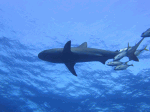 Tugging my fin to slow me down, my buddy signaled, his arms spread, “There’s something big following us.” Assuming it was another reef shark, I turned around to see a humpback whale approaching us. In defensive mode, we glued our backs to the 60-foot reef and watched the whale surface, breach, and then return to check us out a second time. His close proximity limited our view to a barnacle-encrusted flipper. When the humpback glided to a halt—within touching distance—we swam toward him. He descended into the abyss without a ripple in the water.
Tugging my fin to slow me down, my buddy signaled, his arms spread, “There’s something big following us.” Assuming it was another reef shark, I turned around to see a humpback whale approaching us. In defensive mode, we glued our backs to the 60-foot reef and watched the whale surface, breach, and then return to check us out a second time. His close proximity limited our view to a barnacle-encrusted flipper. When the humpback glided to a halt—within touching distance—we swam toward him. He descended into the abyss without a ripple in the water.
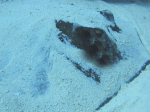 That was back in the mid-80’s, and the underwater encounter remains one of the highlights of my diving career. Needless to say, the rest of that week’s diving in the Turks and Caicos was anti-climatic. I wondered if I would have the good fortune to repeat that serendipitous whale encounter when I signed up for a trip on the Turks and Caicos Explorer diving liveaboard.
That was back in the mid-80’s, and the underwater encounter remains one of the highlights of my diving career. Needless to say, the rest of that week’s diving in the Turks and Caicos was anti-climatic. I wondered if I would have the good fortune to repeat that serendipitous whale encounter when I signed up for a trip on the Turks and Caicos Explorer diving liveaboard.
As we straggled aboard “anytime on Saturday after 3 pm” Operations Manager Jennifer Cumming told us “change your watch to Explorer Daylight boat time, that’s one hour later”. She quickly added, “That’s so we can squeeze four dives into daylight hours.”Don’t worry, you’ll lose an hour of sleep tonight, but you’ll get it back on Friday.” After the hearty welcome and boat tour, she assured each of us that we were in good hands with “relief” Captain Ian Marriott, formerly a Captain on Peter Hughes’ Sea Dancer.
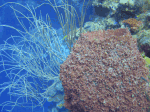 Nicole Schilling, aptly filling in for Jennifer, introduced us to the crew. Two of them would always be on deck observing our bubbles. If we were ever “geographically challenged”—far away and low on air—we could raise a fist for a zodiac pickup.
Nicole Schilling, aptly filling in for Jennifer, introduced us to the crew. Two of them would always be on deck observing our bubbles. If we were ever “geographically challenged”—far away and low on air—we could raise a fist for a zodiac pickup.
At dawn we left Providenciales (Provo) for Northwest Point, motoring about 10-knots for several hours. It was great to be back on one of the Turks and Caicos sheer walls on the very first dive. Several 6 to7 feet reef sharks cruise by, a couple of hawksbill turtles surfaced for air. The reef was covered with large barrel, orange elephant ear and stove-pipe sponges, plus black coral, deep sea fans, and lots of unperturbed Nassau groupers being cleaned by wrasse..
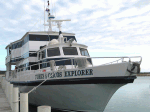 Schools of big eyed jacks circle in a site called the Amphitheatre. In the sand above the wall yellow-headed jawfish peek their heads in and out of holes, the odd anemone was home to Pedersen cleaner shrimp. Atlantic spade fish schooled, while Cubera snapper swam alone.
Schools of big eyed jacks circle in a site called the Amphitheatre. In the sand above the wall yellow-headed jawfish peek their heads in and out of holes, the odd anemone was home to Pedersen cleaner shrimp. Atlantic spade fish schooled, while Cubera snapper swam alone.
This part of the ocean is usually considered the Caribbean Basin, but there is no defined border with the Atlantic, which is where we were actually diving. The water temperature was a cool 79-degrees.
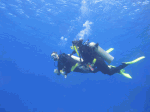 After a day of diving at Northwest Point, the boat motored an hour and a half to spend two days diving at West Caicos Island. Fired up isn’t exactly the best way of saying it. From the top deck, you could barely hear the engine or feel the motion of the boat in calm water.
After a day of diving at Northwest Point, the boat motored an hour and a half to spend two days diving at West Caicos Island. Fired up isn’t exactly the best way of saying it. From the top deck, you could barely hear the engine or feel the motion of the boat in calm water.
The historical stout white cliffs of White Face appear untouched since Christopher Columbus, enroute to Grand Turk, made landfall in West Caicos. Divers can see his 500-year old coral-encrusted anchor in a narrow swim-through.
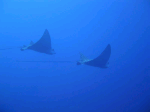 Shark Hotel is running at a low occupancy. The nurse sharks that used to inhabit the area have been replaced by Nassau grouper, yellow-crowned Diamond blenny, and small wire shrimp camouflaged in green coral curly-cues. Loretta, a big Nassau Grouper, has been hanging out in the Gully for so long that she is considered a full time resident.
Shark Hotel is running at a low occupancy. The nurse sharks that used to inhabit the area have been replaced by Nassau grouper, yellow-crowned Diamond blenny, and small wire shrimp camouflaged in green coral curly-cues. Loretta, a big Nassau Grouper, has been hanging out in the Gully for so long that she is considered a full time resident.
Our fourth dive of the day usually ended as the sun was setting, and it was during this time that we usually admired reef sharks on their nocturnal journey in search of an evening meal. Along the wall we admired a channel crab, a similar shaped neck crab, and a pipe-like arrow blenny.
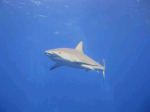 Highway to Heaven could also be the road to decompression—it averages a depth of 90 to140 feet. Wide channels of stark white sand camouflage the deepness of the water as it slopes toward the abyss. Rock Island Interlude has two sand chutes leading to the wall. After about 20-minutes, divemaster Graham became a macro-specialist pointing out a black and grey bearded fireworm attached to a sponge, a camouflaged scorpion fish, a small unrecognizable nudibranch, and a “dice”—a black cube with white spots or juvenile trunkfish. Limestone of the islands creates the whiteness of the sand along with as Captain Ian suggested “a whole lot of coral recycling by parrotfish”
Highway to Heaven could also be the road to decompression—it averages a depth of 90 to140 feet. Wide channels of stark white sand camouflage the deepness of the water as it slopes toward the abyss. Rock Island Interlude has two sand chutes leading to the wall. After about 20-minutes, divemaster Graham became a macro-specialist pointing out a black and grey bearded fireworm attached to a sponge, a camouflaged scorpion fish, a small unrecognizable nudibranch, and a “dice”—a black cube with white spots or juvenile trunkfish. Limestone of the islands creates the whiteness of the sand along with as Captain Ian suggested “a whole lot of coral recycling by parrotfish”
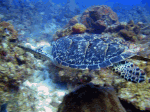 French Cay, about the size covered in a 10-minute walk, is an uninhabited island 15 miles southwest of West Caicos. Access is not permitted; it’s a wildlife sanctuary for nesting terns, osprey, and frigate birds. Lonely Planet’s Turks and Caicos guide book designates French Cay as advanced diving because there is no current protection near the small spit. It’s susceptible to rough seas and windy conditions making it less frequently dived.
French Cay, about the size covered in a 10-minute walk, is an uninhabited island 15 miles southwest of West Caicos. Access is not permitted; it’s a wildlife sanctuary for nesting terns, osprey, and frigate birds. Lonely Planet’s Turks and Caicos guide book designates French Cay as advanced diving because there is no current protection near the small spit. It’s susceptible to rough seas and windy conditions making it less frequently dived.
We lucked out with great weather conditions. At G-Spot, we admired three eagle rays swimming gracefully along the wall. The reef, like many walls in Turks and Caicos, starts at about 50-feet without shallower water to wrap up the dive.
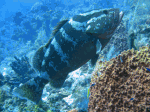 The Explorer had no knowledge of shark feeding at French Cay, but apparently when boat arrive so do Caribbean reef sharks. Three 6-footish Caribbean reef sharks circled below the stern, almost “dive-bombing” divers during their 3-minute safety stop.
The Explorer had no knowledge of shark feeding at French Cay, but apparently when boat arrive so do Caribbean reef sharks. Three 6-footish Caribbean reef sharks circled below the stern, almost “dive-bombing” divers during their 3-minute safety stop.
As promised, throughout the week, the crew kept us busy. It was eat, dive, snack, dive, eat, dive, snack, eat, dive, and sleep. We had two responsibilities—listen for the meal bell or the blowing of the conch signaling the dive. Weather permitting, the diving is easy in the Turks and Caicos, the visibility good to great (60-100 feet), and its steep walls are enthralling.
And for the macro-lover, a striped fingerprint cyphona can occasionally be found on a gorgonian, or a pipe-cleaner-like arrow blenny under a rock; sand lovers can find a Southern stingray or two, maybe a pipefish. There was lots to see, but my dream of another serendipitous encounter with another humpback—well that’s unlikely to ever happen again.
Turks and Caicos Explorer costs $1395.00 per person plus a single supplement of $695.50 for 5 1/2 days of diving plus a $65.00 fuel surcharge and $55.00 bed tax. Explorer Ventures. 800.322.3577 or www.explorerventures.com
Land based day diving:
Art Pickering’s Provo Turtle Divers is the oldest land based dive operation (since 1970). They depart Turtle Cove Marina each morning at 8:15 am and return between 2-3 pm. They limit the boat to 18 divers. The cost is $95.00 for 2 tanks and snacks. 800-833-1341or 649-946-4232
Private charters include: Big Blue Unlimited Private Charters 649.946.5034 [email protected] www.bigblue.tc
Places to stay: Turtle Cove Inn offers divers a clean room, good bed, and plenty of nearby restaurants. The property is located near land based dive operators and the Turk and Caicos Explorer dock. [email protected] www.turtlecoveinn.com, 800-887-0477
Upscale Places to Stay: The Sands 649-946-5199 [email protected]. Don’t miss Hemingway’s on the Beach Restaurant The Palms Grand Resort @ Spa 866.877.7256 www.gopalms.com Sibonne Beach Hotel 800.528.1905 [email protected] or www.sibonne.com Grace Bay Club 800-946-5757 www.gracebayclub.com . Dine in the oceanfront Anacaona Restaurant
Turks and Caicos
The chain is comprised of eight islands and 41 cays, nine are inhabited. While geographically part of the Bahama Banks, the islands are separated 30 miles by the 5000 foot deep Caicos Passage. Many mistakenly think of the islands as part of the Caribbean, but they are actually located in the Atlantic.
Primary tourist destinations are 37-square mile Caicos, and Grand Turk, which is separated from Caicos by the 7000-foot depth of the “Columbus Passage” (formerly called the Turks Island Passage and renamed for the explorer’s first landfall in 1492). Grand Turk and Caicos are 22 miles apart.
Semi-barren, the rocky islands are covered with cacti and thorny acacia islands, and surrounded by 200-miles of reef along gorgeous sandy beaches, secluded coves, sheer vertical walls, almost all protected as a national park.
The Islands are located 575 miles southeast of Miami. First populated by the Lucayan or Arawak Indians, Columbus claimed the islands for Spain in 1492, which ceded them in 1670 to Britain. Turks and Caicos were a dependency of the Bahamas until 1874, before becoming controlled by the Jamaican government. In 1962, the islands became a British crown colony with its own government. Many of the locals, known as “Belongers”, are descendants of slaves brought during the Loyalist settlement of Caicos Island. Others came to work early salt industry.
Today, luxurious hotels and million dollar condos line the beach. Food and taxis are expensive. The monetary system is the US dollar. A passport is required for entry. American Airlines, US Airways, Air Canada, British Airways, Delta, Continental all provide air service.
